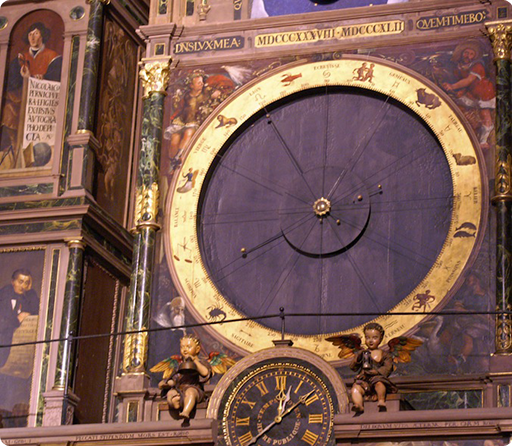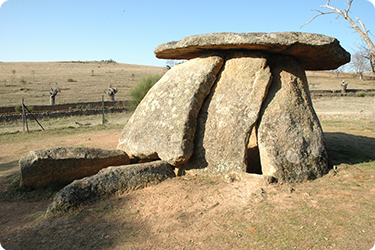The Heritage
About the case studies

Heliocentric planetary dial of the third astronomical clock at Strasbourg Cathedral, France. Photograph © Didier B (Sam67fr), Creative Commons Licence
Each case study on this portal relates to heritage that belongs to one or more categories and to one of more types, as defined below. It may relate to any of the themes identified in the thematic essays. Most (but not all) case studies relate to a particular place (or places) and to a particular span of time.
- The categories are: tangible fixed (‘immovable’); tangible movable; intangible; and natural. See Categories of astronomical heritage for more information.
- The type is a more subjective classification that may be helpful in selecting relevant heritage. The available types include: cultural properties connected with astronomy; astronomical observatories, instruments, and artefacts; starlight reserves and oases; and intangible heritage such as calendars and indigenous practices.
- For a list of the themes see the Themes page.
- Tangible and natural case studies relate directly to a particular place (or places): for example, the location of a fixed site or landscape or the original location (find spot) or current location (e.g. museum or collection) in the case of movable items. For existing and potential World Heritage Sites there is also the complex issue of core and buffer zones (see Creating a credible dossier). In some cases the location is a tightly defined spot; in others it is a relatively large area. Sometimes it is a set of separate spots or areas. The connection(s) to a particular place or places may be most debatable in the case of intangible heritage.
- A case study will typically relate to a particular span of time, although many factors may limit the accuracy to which this can be meaningfully specified.
- Case studies may be presented in different formats. In particular, tangible fixed heritage appears both in the form of short case studies, as used in the first ICOMOS–IAU Thematic Study on astronomical heritage (2010), and full case studies, as used predominantly in the second second Thematic Study (2017). Some case studies relate to cultural or natural properties already inscribed on the UNESCO World Heritage List, or included in national Tentative Lists. The format for movable objects is similar to that for short case studies, as is that for “Outstanding Astronomical Heritage” sites registered by the IAU through its Commission C4 on World Heritage and Astronomy, and additional “Places connected to the sky” submitted more informally by the wider community.
-
Multi-site, or ‘serial’, case studies relate to more than one separate location (e.g. a set of sites or objects—the term is not used for a single object that has been moved). In the case of tangible fixed and natural heritage, such case studies may represent actual or potential serial nominations (see Creating a credible dossier).

Anta de la Marquesa (Mellizo), near Valencia de Alcántara, Spain: one of 177 seven-stone antas, a group of monuments in Portugal and Spain. Photograph © Clive Ruggles
Each of these factors may be filtered in within a search for relevant information using the astronomical heritage finder (see below).
Important note
Our database of case studies should not be regarded as exhaustive in any sense. The principal reasons for including a case study on this portal, from both a regional and global heritage perspective, are to aid discussions about specific and general issues, and to facilitate comparative studies.
As regards potential World Heritage, the inclusion or otherwise of a property (site or landscape) that is not already on the World Heritage List as a case study on this portal has no bearing whatsoever should the State Party concerned decide to nominate the property, or one related to it, for inscription on the List.
Using the astronomical heritage finder
The astronomical heritage finder allows you to identify case studies either on a map or in a list. (On a small-width device such as a phone, only the list option is available.)
Using the filter buttons and timespan slider control it is possible to constrain a search so that only the most relevant astronomical heritage appears on the map or in the list. The main filter buttons are shown on the main screen, with further buttons appearing if "more filters" is selected. Selected options are displayed in GREEN; unselected options in BLUE. The timespan slider displays start and end dates for the date range chosen. The scale is distended towards the "modern" end so as to permit finer selection for more recent dates.
The colour of the marker on the map (or diamond symbol in the list) represents the heritage category concerned, e.g. yellow for tangible fixed. In many cases there is more than format (e.g. both a short case study and a full one). The user can switch between these after the desired case study has been selected from the map or list, by using the case study navigation tree that appears on the right (or at the foot of the page on a small-width device).
For serial case studies, only a single marker is shown on the map by default, at the location of one of the component places that was selected by the author as the "main" site. However, if the "Serial case studies" filter button is set to "all", then all the component places ("nodes") of serial case studies will be shown on the map. All of the additional nodes are shown as circles, while the main place is still shown as a diamond. Once any node of a serial case study is selected, the user can navigate between the nodes using the case study navigation tree.
A case study that a covers significant area is marked on the finder map by a spot at a central location within the area.
Levels of access
In order to ensure that the contents of this database remain authoritative and reliable, levels of access have been carefully structured so that content, and proposed changes to the content, can be openly discussed among the international community but also monitored and moderated at a number of levels. Thus:
- Public users see only published content.
- Registered users can view edited content and discussions.
- The ability to edit content, to view its history, and to discuss proposed changes is restricted to professional users who are specifically granted access privileges by the management team or its advisors. This professional group includes authors of the ICOMOS–IAU Thematic Study on astronomical heritage and members of the IAU’s Commission on Astronomy and World Heritage. Others can join this group by This email address is being protected from spambots. You need JavaScript enabled to view it. and being approved by the editorial team, which contains representatives of UNESCO and its advisory bodies.
- Additions and changes approved by consensus may only verified by a member of the editorial team. Only verified content can be published by the project team.